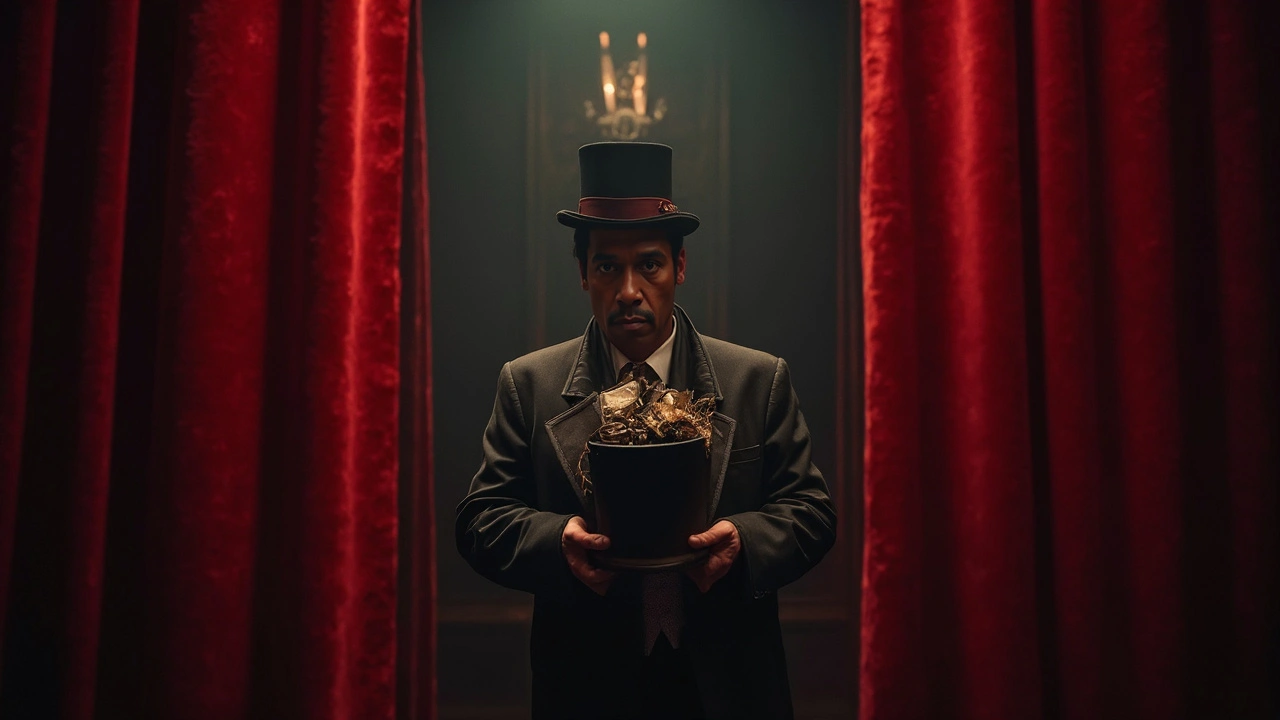Did you know the human brain is practically wired to be fooled? Around 80% of people admit they love watching magic—yet almost nobody thinks they could pull it off themselves. That's wild, considering some of the slickest tricks require nothing more than a rubber band and a bold grin. Magic’s not about hiding things up your sleeve—most of the time, it’s just knowing how to steer someone’s attention. If you’ve ever wanted to get that 'how did you do that?!' reaction, you’re in the right place. Magic’s secret sauce isn’t complicated props or top hats. It’s psychology and practice—stuff you already use every day. So why not repurpose it into something that flat-out stuns people?
Why Magic Tricks Work: The Science and Psychology of Illusion
It’s easy to think magic is just smoke and mirrors, but there’s actually a mountain of fascinating science behind it. Here’s the real deal: magic works because it takes advantage of the way our brains handle information. For example, when a magician waves one hand, your eyes go there—meanwhile, the real action is happening somewhere else. This is called misdirection, and researchers at Sussex University showed in 2015 that our attention drops sharply when magicians intentionally overload us with information. Your brain can’t track every detail even if you think you’re paying attention. If you don’t believe me, try the famous 'Invisible Gorilla' experiment yourself—half of folks completely miss the gorilla striding through a basketball game because they’re too focused elsewhere. Magicians are absolute masters at this.
But it’s not just about fooling your eyes. Magic taps right into memory quirks too. Psychologists call it 'change blindness' and 'choice blindness.' One classic card trick makes people swear they picked a different card than they actually did. Daniel Simons, who helped with the Gorilla experiment, found that when magicians swap items quickly, most people can’t spot the difference. It’s not because they’re not smart—it’s just how brains work. There’s also a social side: when you perform, people expect honest actions, not trickery. That makes it so much easier to get away with sneaky moves. According to Apollo Robbins—a pro pickpocket and illusionist—building rapport with your audience is half the game. If they trust you, their guard goes down, and your job gets a hundred times easier.
The props? They’re usually nothing special. A lot of the world’s best magic tricks rely on everyday objects—coins, cards, or even a salt shaker at a diner. The real skill is shaping what your audience expects, and then dashing those expectations at the perfect second. One more cool fact: MRIs have shown that when someone sees something 'impossible,' their brain lights up like a Christmas tree with both curiosity and delight. It's basically a shot of dopamine for everyone in the room—including you. Pull off your first trick, and you’ll see the crowd buzz—there’s nothing like it.

Beginner Magic Tricks Anyone Can Do (Seriously!)
Let’s bust a myth—nobody is ‘born’ magical. Every top performer today got their start with dead-simple tricks. If you’re new to magic, here are a few classics that will get you instant wow-factor and plenty of practice with the art of misdirection.
- Rubber Band Through Fingers: Grab any regular rubber band. Wrap it around your index and middle fingers, show your hand open, and then in a blink, the band jumps to your ring and pinky. The trick? A simple setup with your fingers. This is a fantastic test of convincing hand gestures and speed.
- The Self-Tying Shoelace: This viral trick exploded on YouTube a few years ago. You just dangle your shoe, give your laces a wiggle, and they seemingly cinch themselves up. The effect is mind-blowing, but the method is a breeze. You tie a partial knot before starting and use one quick tug to seal the deal—no magic socks required.
- The Floating Ring: Take a borrowed finger ring and make it hover up and down on a pencil or pen. There’s a well-hidden thread involved here—nothing special, just a piece of fine black sewing thread taped to your finger or hand. Good lighting makes the thread vanish, and the effect is pure sorcery.
- The Bent Spoon: No, you don’t need psychic powers—just a willingness to practice. You leverage a real spoon, a clever bend tucked under your thumb, and mime the action as you 'rub' the utensil. The reveal? A spoon that looks warped, with both ends. Uri Geller made millions off this idea.
- Card Force: The backbone of almost every card trick. With this classic, you secretly get someone to pick the card you want—without them suspecting a thing. You control where the card goes, how it’s cut, and how it’s revealed. Start simple: try the old 'riffle force,' which is so reliable even Penn and Teller have explained it on TV.
Practice is your friend here. The first time you try these, expect a few fumbles. That’s part of the magic—seriously. Legendary magician Derren Brown admitted he dropped cards hundreds of times before he felt smooth enough to entertain anyone. Focus on your rhythm. Watch your hands in the mirror. Record a video on your phone to catch awkward angles. Magic isn’t about being perfect; it’s about knowing how to make someone gasp and then laugh when you reveal the trick.
Don’t have a magic shop nearby? No problem. The internet is now swamped with free tutorials. Some of the best channels—like Jay Sankey’s YouTube, or Magic Orthodoxy—break down tricks step-by-step. But here’s the real secret: mix up the method with your own style. Once you nail the basics, add personality—make a silly joke, pause at just the right spot, or dare your friends to guess what happens next. Remember, what’s most powerful isn’t the trick—it’s how you sell the moment.

Secrets to Performing Like a Pro: Tips for Wowing Any Crowd
You’ve got a trick or two in your pocket—now how do you actually stop a room, or at least get your family to pay attention at dinner? Pro magicians don’t just rely on the move—they rely on the moment. This is where you turn ordinary sleight of hand into a real show.
First rule: confidence beats skill every time. If you look nervous or whisper your words, people react with doubt. Instead, stand up straight, grin wide, and dive in as if the secret is bulletproof. Confidence actually tricks the brain twice—both yours and your audience’s. Psychologists at Cornell University proved people enjoy a magic act more when the performer looks self-assured—even if their hands are shaking.
Next up, storytelling. Legendary illusionists like David Blaine and Shin Lim turn simple effects into wild narratives. Instead of just making a coin disappear, tell the story of where it’s 'going'—is it teleporting to another pocket? Vanishing into thin air? Hidden in someone’s drink? This makes every trick memorable, not just a puzzling puzzle. Want proof? Kids’ magicians regularly use skits and silly stories because kids need a reason to stay engaged. But adults are no different—give them something to latch onto, and you’ve got them hooked.
Another real-world tip: always control your angles. Even the smoothest move can look suspicious if someone peeks from the wrong spot. When possible, perform tricks head-on, control the lighting if you can, and use a simple hand gesture to steer attention exactly where you need it. That’s how Dynamo did his famous street tricks—he’d turn his back, make eye contact, and then set up the reveal.
Practice with distractions. Your dog might bark, your friend’s phone might go off; seasoned magicians can roll with any interruption. Practice your favorite trick while the TV is on or with someone talking in the room. If you nail it with chaos around, you’ll be rock-solid for showtime. The best illusions are the ones that work anywhere—in the classroom, at a party, or through a webcam. That’s not just impressive. It’s practical, too.
Last, but never least, respect the magic code. Professional courtesy says: don’t reveal secrets unless it’s to someone serious about learning. This preserves the mystery and keeps audiences guessing—because once the secret’s out, the fun drains away fast. And trust me, nothing beats that rush the first time someone’s jaw drops because you totally shattered their expectations of reality.
If you want to keep growing, start connecting with other enthusiasts. Reddit’s r/Magic, The Magic Café, and online Facebook groups are full of people trading tips and new routines. Swap stories, share your fails, and pick up advice—this is how everyone from amateurs to Penn Jillette learns the latest and greatest. There’s even scientific evidence that hobby magicians are better at creative problem-solving, according to a 2022 study out of Michigan State University. Figuring out how to create and perform the impossible builds flexible thinking, boosts confidence, and just flat-out makes you more interesting at every gathering.
Remember, magic isn’t about outsmarting people or making anyone feel foolish. It’s about sharing wonder—and trust me, folks of all ages need that now more than ever. Whether you want to blow minds at a party, break the ice at work, or just rekindle that childhood sense of awe, learning magic puts you in the driver’s seat. Every time you practice, you’re building showmanship, memory, and quick thinking—and before long, you’ll find that the greatest illusion is how much you surprise yourself.


Adithya M
July 17, 2025 AT 22:10Alright, gotta say, this is pretty cool if you're serious about learning some magic. Not just the cheap parlor tricks, but real mind-bending illusions that actually require skill and practice. I appreciate the promise of 'insider secrets' because most beginner guides barely scratch the surface.
One thing that always bugs me is how often tutorials skip the performance aspect entirely. You can master a trick, but if you can't sell it to your audience, it falls flat. So I'm hoping this guide really dives into that.
Plus, step-by-step is a must. Complex magic can be infuriating if they don't break it down well. Can't wait to see what kind of tricks they're talking about here!
Anyone else here learning illusions currently? Let’s share tips on what techniques actually make a trick pop off.
Jessica McGirt
July 20, 2025 AT 19:17This sounds fascinating! I’ve always been intrigued by the art of illusion but never really knew where to start without feeling overwhelmed. The fact that it contains detailed steps and performance advice makes it really inviting for beginners like myself.
Also, I wonder if they cover psychological misdirection as part of their secrets? That part always amazes me because it’s not just about sleight of hand, but how your mind is guided.
I might actually start practicing and try my first public trick soon. Does anyone have advice on how to deal with nerves before performing in front of a crowd?
Donald Sullivan
July 23, 2025 AT 16:39Honestly, magic tricks can be kinda hit or miss depending on the performer. Some people overcomplicate stuff, but others just nail it with charisma and simplicity. I'm all for the insider secrets though, because that’s where the real power lies.
However, I don’t buy into the whole 'make jaws drop' mantra without putting in brutal effort. Practice and hard work is what really separates the pros from the wannabes.
Would love to see if these modern illusions incorporate tech or if it's strictly old-school manual stuff.
Tina van Schelt
July 26, 2025 AT 13:38Totally digging the idea of blending traditional magic with modern flair! The phrase 'mesmerizing magic tricks' really sets a tone of awe and wonder. I hope the guide encourages performers to inject their own personality and creative energy rather than just mimic someone else.
Magic is such a majestic art form because it dances beautifully between reality and fantasy, and performers hold the key to that enchantment. Would be amazing if there are tips on creating atmosphere and storytelling too.
Can someone confirm if this includes card magic? Because that’s my jam, and I’m curious if they cover some unique flourishes.
Ronak Khandelwal
July 29, 2025 AT 16:11✨ Wow, this is literally the key to unlocking wonder for both performer and audience! When you mention "make friends gasp and jaws drop," it paints such a vivid picture of the shared magic moment—it's not just the trick, it’s the connection. That energy is what we all strive for.
💭 Also, I love how it's described as a journey. Learning magic isn’t a quick fix, it’s a beautiful path filled with discoveries about art, psychology, and even philosophy sometimes. Embrace every stumble because they make the magic shine brighter.
🃏 Any recommendations on beginner-friendly illusions that carry a powerful impact? Bonus points if it involves storytelling.
Jeff Napier
August 1, 2025 AT 18:06Look, I gotta say: everyone talking about 'secrets' and 'insider tricks' is just feeding into the magic industry's smoke and mirrors. What if the 'secrets' are just elaborate distractions from something bigger we're not supposed to see? Maybe those illusions are hiding the truth, you know?
Don't get me wrong—learning tricks is fun, but I’m suspicious about all this hype. Who profits off these so-called secrets? And does anyone ever question the origin of these 'modern illusions'?
Anyway, if you want my two cents, I’d suggest focusing on understanding how we can be manipulated visually and cognitively, not just how to fool others with shiny tricks.
Sibusiso Ernest Masilela
August 4, 2025 AT 22:37Only amateurs get dazzled by flashy modern illusions without understanding the fundamentals. True mastery comes from classical technique and perfection, not gimmicks.
Some of these so-called 'modern secrets' are just recycled nonsense from the past, repackaged for the unrefined masses. If you’re serious about magic, invest your time in the classics and master them.
I'm skeptical this guide delivers beyond superficial tricks. Seems like marketing fluff designed to lure naive beginners. True craftsmanship requires blood, sweat, and tears—not shortcuts hidden behind flashy titles.
Daniel Kennedy
August 8, 2025 AT 01:44I think blending classical techniques with modern flair is actually what keeps magic evolving and relevant. Everyone starts somewhere, and guides like this can ignite passion and creativity.
Personally, I encourage learners to not get discouraged by critiques and focus on developing their unique style. Magic should be inclusive and accessible to all who have the drive to learn.
Also, performance tips are equally important as the tricks themselves. Engaging your audience and building confidence on stage is a journey worth embracing.
Taylor Hayes
August 10, 2025 AT 18:18Really appreciate how this post highlights the journey of becoming an illusionist, and not just the tricks. That performance element is something I feel doesn't get enough spotlight in most tutorials.
Being able to connect with your audience, manage pacing, and deliver surprises—it's an art in itself. Anyone here who’s performed live? What was your biggest learning about engagement?
Also, don't stress too much about perfection early on. Magic is about wonder, and sometimes even flubs become part of the charm!
Sanjay Mittal
August 13, 2025 AT 19:43This looks like a solid starting point for both hobbyists and aspiring professionals. The emphasis on step-by-step instructions is crucial because magic can quickly become frustrating without clear guidance.
One tip I’d add is to record yourself practicing to observe what works visually and what looks unnatural. Self-review coupled with performance tips can drastically improve your delivery.
Also, remember that the secret to great magic is in the details: timing, misdirection, and confidence. Those are as important as the mechanics of the trick itself.